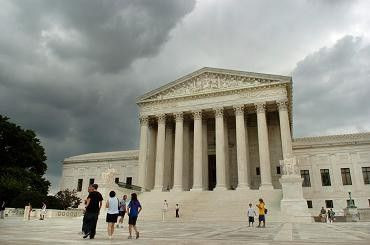Judge-Drawn Texas Redistricting Maps Thrown Out by Supreme Court

The U.S. Supreme Court on Friday tossed out legislative district maps drawn up by a federal court in Texas, ordering the court to instead use maps drawn by the Republican-controlled state legislature as a starting point for crafting new districts before the 2012 congressional and state elections.
In its first ruling on congressional redistricting the result of new population figures from the 2010 U.S. Census, the high court, in an unsigned opinion with no dissents, rejected a new legislative map that would have increased minority representation in the state. The move was thought to favor Democrats and threaten Republicans' chance to gain at least four more seats in the U.S. House of Representatives this election cycle.
To avoid being compelled to make such otherwise standardless decisions, a district court should take guidance from the State's recently enacted plan in drafting an interim plan, the court's opinion said. That plan reflects the State's policy judgments on where to place new districts and how to shift existing ones in response to massive population growth.
The court issued its opinion just 11 days after hearing arguments in the case. For the state's April primary elections to take place as scheduled, new districts maps must be decided on by Feb. 1.
In ruling in favor of the state, the Supreme Court said the San Antonio-based federal court may not have used appropriate standards when it drew its map. Citing its 1982 decision in Upham v. Seamon, the court said that a district court has a duty to defer to the unobjectionable aspects of a state's plan, and said the lower court judges appeared to have unnecessarily ignored aspects of the Texas Legislature's plan when it developed its own.
The interim maps drawn by the judges in Texas were designed to remain in place until a different Washington, D.C. court decided whether the state's plan should be approved or rejected under the federal Voting Rights Act. Under a provision of the law, minorities must have a reasonable chance to elect candidates of their choice. It also specifies that Southern states cannot change their election system until it has been approved by either a three-judge court in Washington or the U.S. Justice Department.
Although Texas has reportedly sought approval from Washington, the special court has indicated it is unlikely to approve at least sections of the legislature's map, according to the New York Times.
Texas, which the U.S. Census reports experienced a 20 percent population boost between 2000 and 2010, is set to receive four additional seats in the U.S. House of Representatives this year to reflect that change.
In particular, Texas' Hispanic population increased significantly, now making up about 38 percent of the state. Minorities are currently the majority in 10 of Texas' 32 congressional districts; the court-approved interim map would have raised that to 13 out of 36 districts.
--
© Copyright IBTimes 2024. All rights reserved.





















